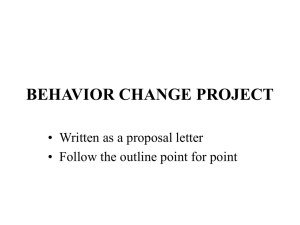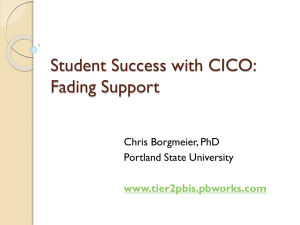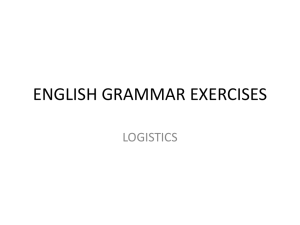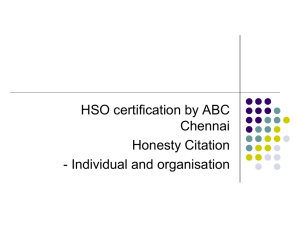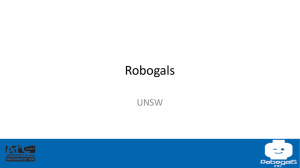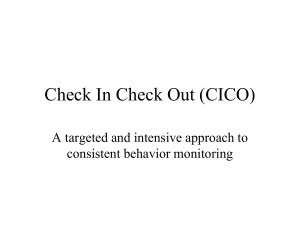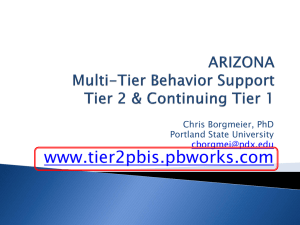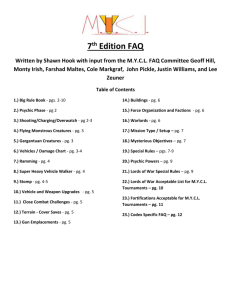Addressing Academic Avoidance at Tier 2
advertisement
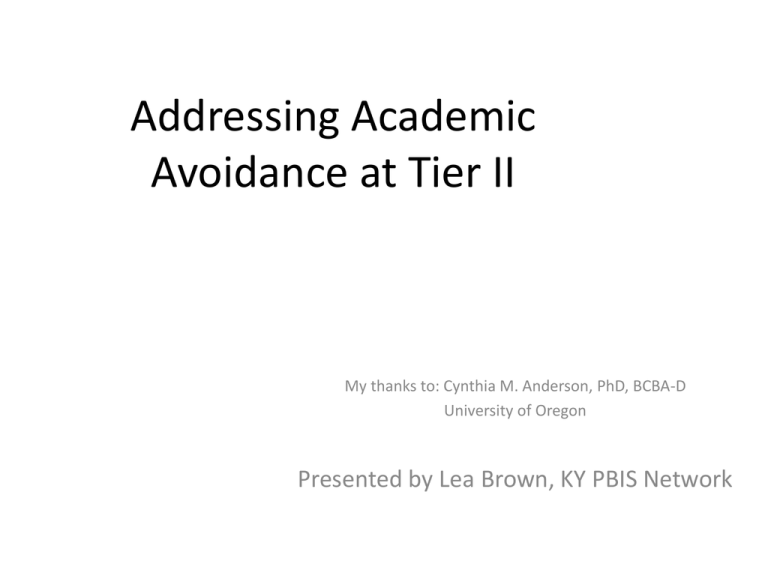
Addressing Academic Avoidance at Tier II My thanks to: Cynthia M. Anderson, PhD, BCBA-D University of Oregon Presented by Lea Brown, KY PBIS Network Agenda • Point card interventions—rationale and background • Point cards within a multi-tiered system • Tier II interventions—enhancing systems for positive and durable outcomes • CICO—a foundation for Tier II interventions • Breaks are Better • Academic Behavior CICO Point Card Interventions in Schools • Target behaviors operationally defined • Assessment of student behavior – Pre-determined times – Numerical scale with defined values • Contingencies for target behavior • Home component • Robust research base (e.g., Chafoulas et al., 2002, 2005; Dougherty & Dougherty, 1977; Fabiano et al., 2010; Schumaker et al., 1977) • Reliance on home contingencies • Selection process inconsistent • Individualized – Target responses – Evaluation metric and schedule – contingencies Traditional “home-school notes” may be difficult to scale up Tier I • Intervention for ALL students • Effective: 80% or more meeting benchmarks 5 5 Tier I • Intervention – Explicit instruction – Opportunities to practice in target settings – Feedback • Systems – Defined and measurable outcomes – Student progress monitored – Team-based problem solving, coaching Considerations • Simply “having” Tier I doesn’t guarantee – Teachers are implementing – All students have access • “At risk” students need proactive behavior management • Before implementing more intensive support, ask yourself… At least 80% of students are successful…what about the rest? 8 8 Tier III 9 9 Tier II Core + Supplemental 10 10 Tier II Interventions • Match needs of school • Are implemented rapidly – Similar across students Enhance fidelity – Staff trained in intervention – Materials on hand • Match problem – Intensity – Mechanism (skill, fluency, or contingency deficit • Use data-based decision-making – Who will likely benefit? – Is the intervention working? – Next steps Tier II Assessm ent Tool CHECK-IN/CHECK-OUT: TIER II BEHAVIOR REPORT CARDS Student Recommended for CICO CICO is Implemented CICO Coordinator summarizes data for decision making Morning check-in Parent feedback Regular teacher feedback Afternoon check-out Bi-weekly coordination Meeting to assess student progress • 10 studies to date • Elementary school (7) & middle school (3) • Decrease disruptive behavior & enhance academic engagement (e.g.,Campbell & Anderson, in press; Fairbanks et al., 2007; Hawken & Horner, 2003; Simonsen et al., 2010; Todd et al.,2008) • CICO most effective for students emitting attention-maintained behavior (Campbell Empiricalproblem Support & Anderson, 2008; March & Horner, 2007; McIntosh et al., 2009) ACADEMIC BEHAVIOR CICO J. Turtura • Shares several features with CICO – Morning and afternoon checks in and out – Daily point card is foundation – Similar across students receiving intervention – Data guide decision-making • Modifications designed to – Increase structure and feedback around recording assignments – Provide specific feedback for academic-related expectations – Decrease likelihood of being “set up” for a bad day – Provide incentives for positive academic behavior Academic Behavior CICO Components of ABC • • • • Morning check-in Daily feedback sessions Afternoon check-out Home session Morning Check-in Student meets with coordinator/mentor • Is student prepared? • Are assignments complete? • Review home note • Provide point card & tracker 2 points possible 3 points per expectation & 1 point for use separate tracker tracker • Student keeps point card (or and have student turn in to teacher) • Student meets academic expectations • Student completes assignment tracker • Feedback at end of class period – Academic expectations – Homework recorded accurately Daily Feedback Sessions Afternoon Check-out Student meets with coordinator/mentor • Review point card--% points earned – Provide incentives if using – Positive verbal feedback • Review homework tracker—plan for work 2 points completion possible • Complete home note • End with encouragement Points Possible How Points are Earned Morning Check-in 2 Student has materials (1) and work is complete (1) Feedback Up to 3 per expectation Meet behavioral and academic expectations Homework Tracker 1 per feedback session Assignments recorded correctly 2 Attend checkout (1) and have teacher(s) signature (1) Activity Afternoon Check-out • Location • Materials available – Minimum: pencils, paper, erasers, etc. – Consider individual items such as textbooks • Homework completion – Complete now—get pass to be late to class – Complete later—receive homework pass – 3 or Morning more incompletes in 2-week period: consider Check-in Logistics new intervention Home Component • Parent workshop first! Parent Workshop • • • • • Approximately 20 min Overview of ABC Establishing a homework routine Planning for long-term projects Organizing for success Home Component • Parents do: – Review Assignments – Problem-solve homework completion/study plan – Complete home note • Parents do not: – Complete work for child – Argue, use continued reminders – Offer additional incentives or negative consequences Justin Boyd BREAKS ARE BETTER Breaks are Better (BrB) • Shares several features with CICO – Morning and afternoon checks in and out – Daily point card is foundation – Similar across students receiving intervention – Data guide decision-making • Modifications designed to – Provide specific feedback for academic-related expectations – Decrease likelihood of being “set up” for a bad day – Provide incentives for positive academic behavior – Provide “replacement skill” to obtain brief break Morning Check-in • • • • Student meets with coordinator/mentor Is student prepared? Review home note Provide point card, timer, & tracker 2 points possible • • • • Daily Feedback Sessions Student keeps point card Student meets academic & social behavior expectations Student takes breaks when needed Feedback at end of class period – Meeting expectations 3 points per – Taking breaks if needed expectation & 1 point for tracker use Afternoon Check-out Student meets with coordinator/mentor • Review point card--% points earned – Provide incentives if using – Positive verbal feedback • Complete home note • Student turns in timer • End with encouragement 2 points possible • Student engages in academic routines • Student can request a break • 2 min break • Specific activities during break • Student returns to work after break Breaks are Bettter BrB During Academic Routines Common Questions/Concerns • Why should we allow breaks? • Three breaks is too many! Points Possible How Points are Earned Morning Check-in 2 Student attends checkin (1) and has materials (1) Feedback Up to 3 per expectation Meet behavioral and academic expectations Break Tracker 1 per feedback session Taking breaks appropriately if needed 2 Attend checkout (1) and have teacher(s) ratings (1) Activity Afternoon Check-out WORK TIME: PLANNING FOR IMPLEMENTATION Implementation Planning • • • • Planning for ABC and BrB Developing daily progress report Progress monitoring Implementing ABC and BrB • Selecting coordinator(s) • Modifying school-wide expectations Planning for Implementation • Intervention Coordinator Roles and responsibilities – Ensure materials are available – Maintain staff buy-in – Train teachers, students – Inform parents – Monitor outcomes – Problem-solve • Key characteristics – Fluent with ABC or BrB – Respected by adults and students – Time and skills to “make things happen” Coordinator options • One coordinator for whole school (CICO, BrB, ABC) • One coordinator for each intervention • Multiple roles per or across interventions – One person monitors data and trains across intervention(s) – One or more individuals perform check in and out – One or more individuals enter data* Liberty Elementary School—300 • Counselor students, 18 on CICO,• 14 on BrB Counselor ddddddddd • • • • • Organize Materials Train staff, student, families Graph data Oversee progress monitoring Check students in and out • Counselor • Counselor ddddddddd • Counselor • • • • • – Program graduate/parent Oceanside Middle—520 students 28 on CICO, 24 Organize Materials volunteer ccccddddd on ABC • Counselor dddddbbbbbddd Train staff, student, families Graph data Oversee progress monitoring Check students in and out • IA • Counselor/IPBS team • Counselor (12 ABC, 5 “advanced” CICO) Librarian (12 ABC), CICO: head receptionist, vice principal, grandparent volunteer Action Plan (ABC p 4, BRB p 5) • Selecting coordinator • Modifying school-wide expectations Expectations are… • Linked to school-wide expectations • All students have same academic expectations – Easy to implement – May not always match each student’s needs • Students have individualized expectations – Easier to match student needs – May reduce fidelity p. 5 ABC; p 6, BrB Implementation Planning • • • • Planning for ABC Developing daily progress report Progress monitoring Implementing • • • • School-wide expectations academic expectations Designing DailyAND Progress Reports Age appropriate rating scale Teacher friendly Data easy to summarize and determine if goal is met • DPR Variations to Consider Morning check in – Points tied to specific behaviors? – Plan if homework isn’t completed • Daily feedback – BrB: how many breaks to be allotted? – ABC: points for assignments after each class (1,0 or 2,1,0) • Afternoon check out – Points tied to specific behaviors – Home component Workbook (ABC, p 5; BrB, p 6) Develop Progress Report (Appendix A) • Modify point card to fit your school • Homework tracker? • Rationale: Enhance strength of intervention • Ideal: Positive adult interaction functions as reinforcer • Options – No incentives, just adult contact/relationship – Add incentive system for all – Incentives are for participation only – Students earn incentive for meeting point goal on 4/5 days – Incentives purchased for varying points Using Incentives in ABC and BrB Acknowledgement Ideas • Small tangible items (e.g., stickers, snack, art supplies) • “Secret teacher” note • Extra time in preferred activity (e.g., library, computer) • Seat choice at lunch • SWPBS points, trip to treasure chest • Free ticket to school event (e.g., sports game) • Parking pass for a day • Lunch with principal or favorite teacher/staff ABC P 6; BrB P 8 Implementation Planning • • • • Planning for ABC Developing ABC daily progress report Progress monitoring ABC Implementing ABC Data-Based Decision-Making at Tier II • Standardized assessment/SpEd eligibility • Group conversations • Best guess • Determine progress goals Monitoring Student Progress • Identify measurement system • Set timeline for achieving goals 80% of points for 4 out of 5 days within two weeks Work book p 8 Options for Progress Monitoring • CICO/SWIS • IPBS spreadsheet (http://coe.uoregon.edu/ipbs/) • Make your own spreadsheet ABC BrB Selecting Students for Intervention • Standard selection criteria • Consider – – – – Students not succeeding on CICO Students recommended by others Teacher referral indicates work avoidance Off-task behavior is key problem Implementation Planning • • • • Planning for ABC Developing ABC daily progress report Progress monitoring ABC Implementing ABC Introduce ABC to Parents • ABC Parents Guide (http://coe.uoregon.edu/ipbs/) • Hold parent meeting – Purpose of ABC and why child was selected – Develop homework routine with parents – Review positive ways to respond to child when • Daily goals are or are not met • Homework is or is not completed • Provide rationale • Obtain student buy-in – Student is eager – Student uncertain – Student unwilling • Student contract (Appendix C, p. 15) Introduce ABC to Students GETTING STARTED: A FEW TIPS What Notcandidates to Do • Start with ALL possible • Begin with the most difficult students • Begin with students of most challenging teachers Begin with 3-5 students Students and teachers most likely to succeed Resources http://coe.uoregon.edu/ipbs/ Click on Tools

